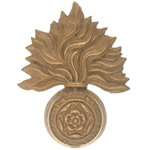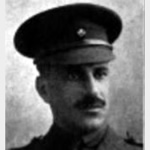Commemorated: | |||
| 1. Memorial: | Guards Cemetery, Windy Corner, Cuinchy | IX. A. 31. | |
| 2. Book: | The (1921) Masonic Roll of Honour 1914-1918 | Pg.130 | |
| 3. Memorial: | The (1940) Scroll - WW1 Roll of Honour | 58A GQS | |
Awards & Titles: | |||
Early Life :
Family Home1 East Park Terrace Southampton, Hampshire, England
Family :
Son of Mr. and Mrs. Sidney Myer, of Southampton; husband of Emma Myer, of 123, Inverness Terrace, Bayswater, London.PARENTS
Father: Sydney Myer
Mother: Sophy Alex
SIBLINGS
Abraham J. Alex Myer (male)
Hannah C. Alex Myer (female)
Montague Alex Myer (male)
Sydney Alex Myer (male)
Denzil Grenville Alex Myer (male) - Lt KIA 25/2/1917
Nephew of Horatio Myer MP for North Lambeth and a member of the LCC.
Education & Career :
Educated at St Johns Wood School and then University College School, London, preceding his brother Lt Denzie Myer.
He was admitted a Solicitor in 1897, practising at 46-47 London Wall. E.C.
Service Life:
Campaigns:
- The First World War 1914-1918, World-wide.
| Unit / Ship / Est.: 6th Battalion London Regiment (City of London Rifles) |
1/6th (City of London) Battalion (Rifles) August 1914 : at Farringdon Road. Part of 2nd London Brigade, 1st London Division. Moved on mobilisation to Bisley, going on in September to Crowborough. 5 November 1914 : moved to Watford and transferred to 4th London Brigade in 2nd London Division. 18 March 1915 : landed at Le Havre. 11 May 1915 : formation renamed 140th Brigade in 47th (2nd London) Division. 31 January 1918 : transferred to 174th Brigade in 58th (2/1st London) Division, absorbed the disbanded 2/6th Bn and renamed 6th Bn. |
| Action : The Battle of Neuve Chapelle and subsidiary actions |
Following a winter in the trenches the BEF was prepared to take the offensive against the Germans. The location was Neuve Chapelle, a small village in the front line below Aubers Ridge near Lille. Aubers Ridge was a low but significant hill and the intention at Neuve Chappell was to punch through the German front line, occupy the ridge and exploit with cavalry. It was a battle fought by two Corps of the BEF, the Indian Corps and IV Corps both largely consisting of regular battalions. It was to be preceded by the most violent artillery barrage of the war to date. Unfortunately in what was to be the start of the 'learning curve' for the BEF the artillery barrage, whilst violent, failed in some parts ? a failure that was to be costly and which delayed the assault and allowed the Germans to recover. Whilst the men were exceptionally brave they became bogged down as German machine guns and artillery stopped the momentum of the assault and by the end of the first day (10th March 1915) they were digging in. The following day the assault was repeated with fresh battalions but with no success. By the 12th March the Germans had recovered their poise, had brought in reserves and were ready to counter attack.
Neuve Chapelle (10-12 March 1915) was the first planned offensive battle by the BEF in France and achieved limited tactical success but not the expected breakthrough. It highlighted the problem of delay in execution that allowed the defending Germans to regroup, often consequent on small incidents and errors. Having stabilised the situation following the German sweep into France and the counter attack that eventually established static trench warfare on the western front, there was significant pressure on Britain to take a share of the burden from the French (who had without question had born the brunt of the fighting). Although the battle was effectively over by 12th March, the official battle nomenclature included actions in other sectors up to 22 April 1915 including the significant actions at St Eloi and at Hill 60 (Ypres).
Detail :
Source; The Fighting Territorials (Volume 2) - Hurd, Percy "Their baptism of fire was at La Bassee on their way to an inspection, and some days were also spent in digging new trenches under fire. On April 2 the first man to be killed in the battalion was shot in the fire trench. At this time the companies were taking turns in the trenches. On the 3rd the 6th Battalion lost their first officer, Major Myer, who was killed". MYER, ERNEST ALEX, Major. 6th (City of Loudon) Battalion, The London Regiment 4th son of Sydney Myer, of Southampton, he was born Southampton, 23rd November 1874 and educated at St. John's Wood School and University College School. He was admitted a Solicitor in 1897, practising at 46-47 London Wall. E.C. He was a keen volunteer, and soon after leaving the University College School, joined the Victoria Volunteer Regiment which was afterwards amalgamated with the St. George's Rifles and on 26th November 1901 he received a commission in the 2nd London Rifles which became the 6th City of London Rifles on the organisation of the Territorial Force. He was promoted Captain in 1898 and on the outbreak of war at once volunteered for foreign service. The 2nd London division, to which he was attached, left for the Front on 20th March 1915, and he was killed in action near Givenchy, 3rd April 1915. He was struck by shrapnel while passing through the trenches on inspection duty with Col. Simpson, and buried at Cuinchy close to where he fell. In a letter to Mrs. Myer, Col. Simpson wrote: This Battalion has lost an officer who cannot be replaced he was loved and respected by all ranks. Our country has lost a fine English gentleman, who had a very keen sense of duty and the determination to do it. He died the death of the brave soldier that he was. He was an authority on apprenticeship (he published a text book on apprenticeship entitled Apprenticeship Law), and acted for many years as hon. solicitor to the Industrial Department of the Jewish Board of Guardians, to the Apprenticeship and Skilled Employment Association, and to the Apprenticeship Committee of the Women's University Settlement. He was one of the founders of the Brady Street Club in East London. Major Myer was called The Boys' Friend. He was very keenly interested in their welfare, and many a boy in good and lucrative situations today owes it only to his help. In a quiet unassuming way he did splendid service for the Boy's Clubs and for the young men belonging to them, and never spared himself where the lads interest and welfare were concerned. Many of the old members and others have cause to be grateful to him for a start in life, and many for valuable help in other ways. The Maidenhead Cub Scouts, too owe their foundation to him. He married at the Bayswater Synagogue. London his wife Emmy. He left a legacy to benefit apprentices as follows; Registered Charity 209723 - THE BOARD OF GUARDIANS AND TRUSTEES FOR THE RELIEF OF THE JEWISH POOR REGISTERED (COMMONLY CALLED THE JEWISH WELFARE BOARD) Subsidiary Charity 209723-15 THE ERNEST ALEX MYER FUND Governing document: LEGACY 1917 Charitable objects: INCOME FOR POCKET MONEY FOR LADS WHO HAVE BEEN APRENTICED TO A TRADE AND EMIGRATED WITH THE ASSISTANCE OF THE BOARD. It was not until February 2006 that the fund was exhausted.
Masonic :
| Type | Lodge Name and No. | Province/District : |
|---|---|---|
| Mother : | Halcyon No. 3546 E.C. | London |
Initiated | Passed | Raised |
19th May 1913 | 17th November 1913 | 19th January 1913 |
Source :
The project globally acknowledges the following as sources of information for research across the whole database:
- The Commonwealth War Graves Commission
- The (UK) National Archives
- Ancestry.co.uk - Genealogy, Family Trees & Family History online
- ugle.org.uk - The records of the United Grand Lodge of England including the Library and Museum of Freemasonry
Additional Source:
- Founder Researchers : Paul Masters & Mike McCarthy
- Researcher : Bruce Littley

